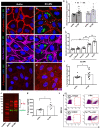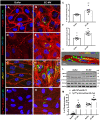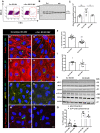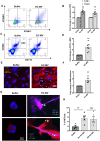Endothelial microvesicles carrying Src-rich cargo impair adherens junction integrity and cytoskeleton homeostasis
- PMID: 31504252
- PMCID: PMC7314637
- DOI: 10.1093/cvr/cvz238
Endothelial microvesicles carrying Src-rich cargo impair adherens junction integrity and cytoskeleton homeostasis
Abstract
Aims: Microvesicles (MVs) conduct intercellular communication and impact diverse biological processes by transferring bioactive cargos to other cells. We investigated whether and how endothelial production of MVs contribute to vascular dysfunction during inflammation.
Methods and results: We measured the levels and molecular properties of endothelial-derived MVs (EC-MVs) from mouse plasma following a septic injury elicited by cecal ligation and puncture, as well as those from supernatants of cultured endothelial cells stimulated by inflammatory agents including cytokines, thrombin, and complement 5a. The mouse studies showed that sepsis caused a significant increase in total plasma vesicles and VE-cadherin+ EC-MVs compared to sham control. In cultured ECs, different inflammatory agents caused diverse patterns of EC-MV production and cargo contents. When topically applied to endothelial cells, EC-MVs induced a cytoskeleton-junction response characterized by myosin light chain phosphorylation, contractile fibre reorganization, VE-cadherin phosphorylation, and adherens junction dissociation, functionally measured as increased albumin transendothelial flux and decreased barrier resistance. The endothelial response was coupled with protein tyrosine phosphorylation promoted by MV cargo containing c-Src kinase, whereas MVs produced from c-Src deficient cells did not exert barrier-disrupting effects. Additionally, EC-MVs contribute to endothelial inflammatory injury by promoting neutrophil-endothelium adhesion and release of neutrophil extracellular traps containing citrullinated histones and myeloperoxidase, a response unaltered by c-Src knockdown.
Conclusion: Endothelial-derived microparticles cause endothelial barrier dysfunction by impairing adherens junctions and activating neutrophils. The signalling mechanisms underlying the endothelial cytoskeleton-junction response to EC-MVs involve protein phosphorylation promoted by MV cargo carrying c-Src. However, EC-MV-induced neutrophil activation was not dependent on c-Src.
Keywords: Barrier function; Endothelial cells; Inflammation; Microvesicles; Neutrophils.
© The Author(s) 2019. Published by Oxford University Press on behalf of the European Society of Cardiology.
Figures







Similar articles
-
SCUBE2 regulates adherens junction dynamics and vascular barrier function during inflammation.Cardiovasc Res. 2024 Nov 5;120(13):1636-1649. doi: 10.1093/cvr/cvae132. Cardiovasc Res. 2024. PMID: 38870316
-
Differential regulation of endothelial cell permeability by high and low doses of oxidized 1-palmitoyl-2-arachidonyl-sn-glycero-3-phosphocholine.Am J Respir Cell Mol Biol. 2012 Mar;46(3):331-41. doi: 10.1165/rcmb.2011-0153OC. Epub 2011 Oct 13. Am J Respir Cell Mol Biol. 2012. PMID: 21997484 Free PMC article.
-
Myosin light chain phosphorylation facilitates monocyte transendothelial migration by dissociating endothelial adherens junctions.Cardiovasc Res. 2011 Dec 1;92(3):456-65. doi: 10.1093/cvr/cvr240. Epub 2011 Sep 9. Cardiovasc Res. 2011. PMID: 21908648
-
Dynamic Regulation of Vascular Permeability by Vascular Endothelial Cadherin-Mediated Endothelial Cell-Cell Junctions.J Nippon Med Sch. 2017;84(4):148-159. doi: 10.1272/jnms.84.148. J Nippon Med Sch. 2017. PMID: 28978894 Review.
-
Hydroxyalkenals and oxidized phospholipids modulation of endothelial cytoskeleton, focal adhesion and adherens junction proteins in regulating endothelial barrier function.Microvasc Res. 2012 Jan;83(1):45-55. doi: 10.1016/j.mvr.2011.04.012. Epub 2011 May 6. Microvasc Res. 2012. PMID: 21570987 Free PMC article. Review.
Cited by
-
Extracellular Vesicles as Mediators in Atherosclerotic Cardiovascular Disease.J Lipid Atheroscler. 2024 Sep;13(3):232-261. doi: 10.12997/jla.2024.13.3.232. Epub 2024 Aug 26. J Lipid Atheroscler. 2024. PMID: 39355407 Free PMC article. Review.
-
Anticipating the long-term cardiovascular effects of COVID-19.J Thromb Thrombolysis. 2020 Oct;50(3):512-524. doi: 10.1007/s11239-020-02266-6. J Thromb Thrombolysis. 2020. PMID: 32880795 Free PMC article. No abstract available.
-
Lung endothelial cell senescence impairs barrier function and promotes neutrophil adhesion and migration.Geroscience. 2025 Jun;47(3):2655-2671. doi: 10.1007/s11357-025-01517-9. Epub 2025 Jan 16. Geroscience. 2025. PMID: 39815038 Free PMC article.
-
Global trends in research on endothelial cells and sepsis between 2002 and 2022: A systematic bibliometric analysis.Heliyon. 2023 Dec 12;10(1):e23599. doi: 10.1016/j.heliyon.2023.e23599. eCollection 2024 Jan 15. Heliyon. 2023. PMID: 38173483 Free PMC article. Review.
-
Immune and inflammatory mechanism of remote ischemic conditioning: A narrative review.Brain Circ. 2023 Jun 30;9(2):77-87. doi: 10.4103/bc.bc_57_22. eCollection 2023 Apr-Jun. Brain Circ. 2023. PMID: 37576576 Free PMC article. Review.
References
Publication types
MeSH terms
Substances
Grants and funding
LinkOut - more resources
Full Text Sources
Medical
Molecular Biology Databases
Research Materials
Miscellaneous

